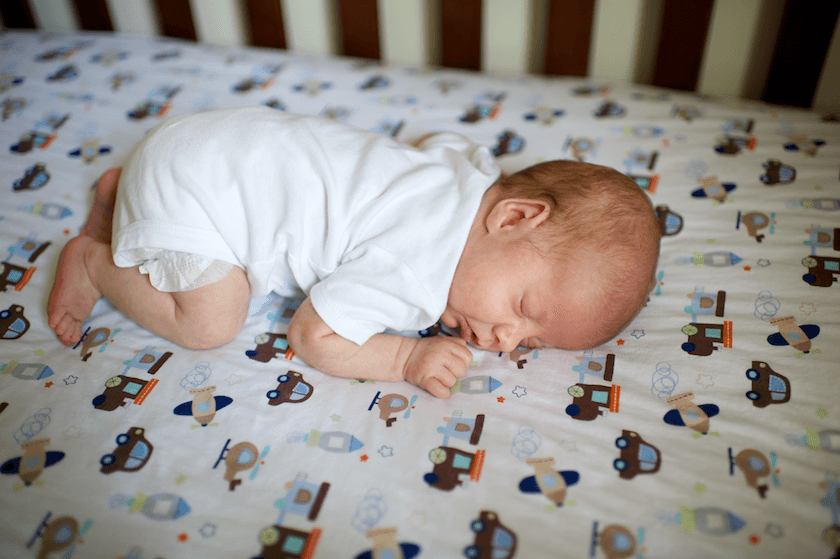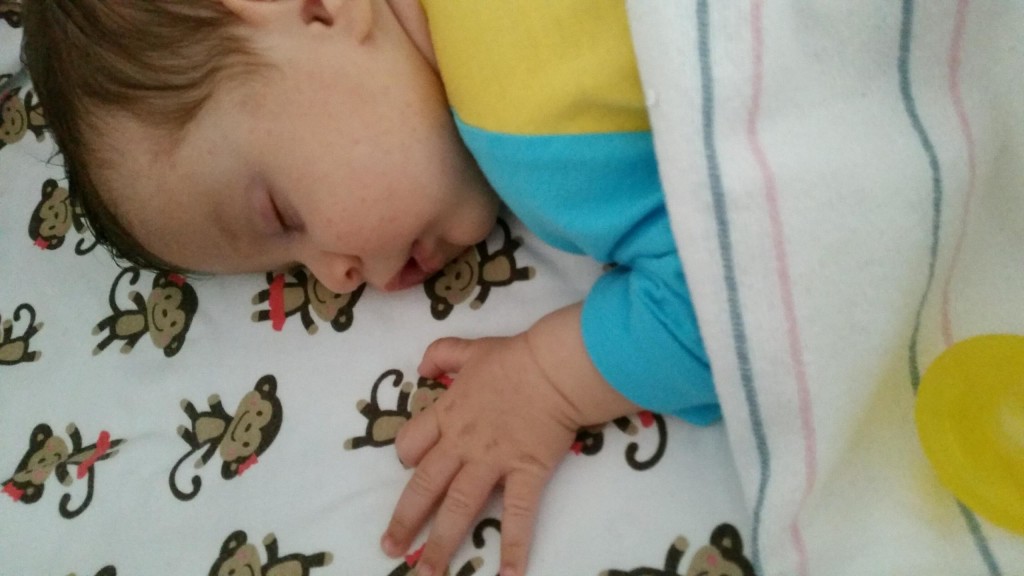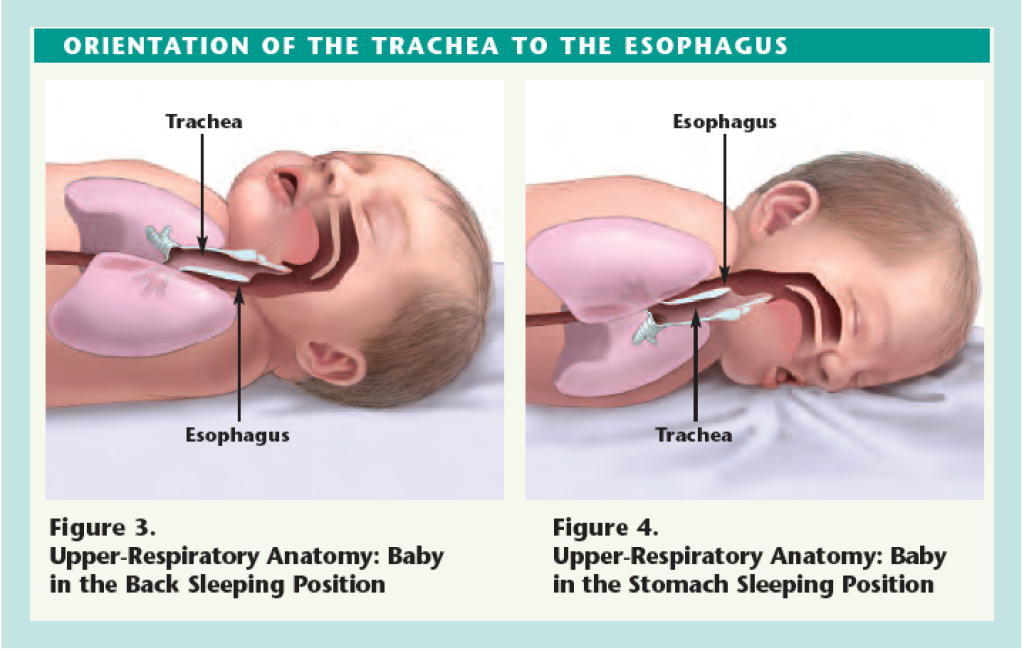Is it safe for my baby to sleep on their stomach?
This is a really interesting, controversial and quite important question.
For the last 20 years, the US government, along with the American Academy of Pediatrics (AAP) and other child advocacy groups have all urged parents to put infants on their backs to sleep for the entire first year to reduce to risk of SIDS.
However, “baby sleeping on their stomach” is a very frequently searched question on Google – and a lot of infants are put to sleep on their stomachs.
Including my own little one for the first few months of life. Below is a photo of my little girl, sleeping on her stomach.
I will say… that I would NOT have let her do this UNLESS she was able to lift and turn her head from side to side – which at this point, she was.
At the daycare we used, they do not allow sleeping on tummy so they wrapped her in a Merlin’s Magical sleepsuit – and I was surprised to hear that she slept fine!
After sleeping on her stomach for over a month, she now sleeps on her back in that sleep suit.
But it really raises some questions in my mind about sleeping positions – what’s the best sleeping position for your baby, and more importantly: is letting your baby sleep on their stomach dangerous?
Table Of Contents
- 1 SUID, SIDS – Facts, Statistics and Terminology About Sudden Infant Deaths
- 2 SIDS (SUIDS) and Tummy Sleeping – Is Sleeping on Their Front Really That Dangerous?
- 3 In a world where both back and stomach sleeping could potentially pose a threat to your infant child – what do you do?
- 4 6 Precautions to Follow for Baby Sleeping
- 5 1. Firm, Not Soft Bedding
- 6 2. No Smoking
- 7 3. Keep Sleeping Baby Close, But Not in Your Bed
- 8 4. Breastfeed as Long as You Can
- 9 5. Vaccinate Your Baby
- 10 6. Don’t Overheat Your Baby
- 11 Related Questions
SUID, SIDS – Facts, Statistics and Terminology About Sudden Infant Deaths
While it can be a scary thing to talk about, it’s really important to know the facts about sudden infant deaths, in order to make it possible for parents be fully educated.
So, here we’ll discuss in more statistical, definitive terms about SUID, SIDS and unexpected infant losses.
In the last years, the terms surrounding unexplained/unknown infant deaths have become a bit blurry – so I’ll do my best to break down our research below.
The CDC (Center for Disease Control) suggests in this article, that SUID (sudden unexpected infant death) is a term that can be used to encompass all sudden infant deaths, including (but not limited to) SIDS.
This is important because SIDS is not all encompassing.
SIDS (sudden infant death syndrome) is a term used to describe the unexplained death (usually during sleep) of a seemingly healthy baby under the age of one year (according to this Mayo Clinic article.)
SIDS is the label assigned to infant deaths that cannot be explained after an autopsy, a thorough examination of the scene, and a review of the baby’s medical history.
However, some infant deaths, however unexpected, can be explained – which makes it difficult to put them under the term of SIDS, which is usually defined as an unknown cause of death.
So, the umbrella of SUID covers:
- sudden infant death syndrome (SIDS)
- death by unknown cause
- accidental suffocation and/or strangulation in bed
Because of the all-encompassing description – SUID (sudden unexpected infant death) is a more accurate term when it comes to sudden or unexpected infant deaths.
SIDS (SUIDS) and Tummy Sleeping – Is Sleeping on Their Front Really That Dangerous?
The most recent facts point to yes – tummy sleeping is more dangerous than sleeping on their back.
I say “most recent”, because until a while ago, it was considered that back sleeping was dangerous and that tummy sleeping was the right way to go.
The idea of putting your child to sleep on their back (and this being the safest route) increased dramatically after the introduction of the “Back to Sleep” campaign was first introduced some 20 years ago, in 1994.
It was a fairly revolutionary change because, until that time, parents were urged to put babies to sleep on their stomachs so there would be no danger of them spitting up and choking to death on it.
It’s certainly easy to see why parents would get confused with this shift in advisories.
But this is what happens – we learn and grow. More information emerges and we try to adapt with it. Doctors learn more things based on statistics (like we talked about above) and they pass that information onto parents who try their best to protect their children.
Now that we’ve talked about the facts – we need to dive into more relatable topics.
Because as a parent, it’s not about facts and statistics – it’s about keeping your baby safe and doing as much as you can to protect them from the unexpected. And there is nothing clerical or statistic about the scary possibility of losing your child to an unexpected event.
How, then, do parents know what the best position is for their babies?
The answer is a little more complicated than a simple “back” or “tummy” response.
“Since the boom of back sleepers in 1994, there has been little improvement in the SIDS rate since then, and little change in the share of infants who are put to sleep on their backs. This is very worrisome given the rate of SIDS, which has been stagnant over several years,” explained Dr. Sunah Hwang of Boston Children’s Hospital and South Shore Hospital in an 2014 interview with NBC News.
So, why are parents so often putting their infants to sleep on their stomachs, despite countless warnings of SIDs?
The reason parents disregard the warning to put babies under age 1 to sleep on their backs is because they are worried about babies choking on vomit, which used to be the reason doctors advised parents to put their infants to sleep on their stomachs.
You can see, then, what a dilemma a parent has. That’s the thing, about sudden infant deaths – there is very, very rarely anything a parent could have done to prevent it – because it’s so often unexplained. And when it is explained, it’s an unexpected, uncommon thing to happen.
In a world where both back and stomach sleeping could potentially pose a threat to your infant child – what do you do?
Well, digging a bit more into the research would suggest that in fact, putting your infant to sleep on their backs is the safest route. Because, what most parents don’t realize is that our bodies are programmed to react in the rare event that vomiting while sleeping should occur.
The risk of SIDS peaks between 1 and 4 months of age.
When your baby is strong enough to roll over, you don’t need to worry about this so much.
He will likely roll through many positions at that point throughout the course of the night.
Once he is rolling over on his own though, you should still put him down to sleep on his back until he is a year old.
6 Precautions to Follow for Baby Sleeping
While you can’t possibly predict any accident that could occur (which is why they are called accidents) – it is important for parents to do everything they can to protec their infants – which includes taking some precautions.
Putting your baby to sleep on his back is the biggest precaution to take in order to reduce the risk of SIDS, period.
However, you’ll also want to make sure to you’re taking all possible precautions to reduce the risk of SIDs – and if your child does sleep on their stomach, here are some extra precautions you could take.
1. Firm, Not Soft Bedding
To prevent smothering or suffocating, always lay your baby down to sleep on either a firm mattress or surface in a crib or bassinet.
The mattress should be covered with a fitted sheet.
You don’t need anything else in the crib and that includes blankets, quilts, pillows, sheepskin, stuffed toys, or crib bumpers.
If you’re worried about your baby getting cold, use a sleep sack. (They are absolutely wonderful, life saving inventions!)
2. No Smoking
Here’s a huge reason to stop smoking: babies that are born to women who smoke during pregnancy are more likely to suffer from SIDs than babies born to nonsmokers.
If you refrained from smoking during pregnancy, but smoke now as a new mom – there is a very high chance it’s still causing danger to your child. In fact, there is no safe amount of second hand smoke, according to this article by the CDC.
It’s not just smoking during pregnancy that could elevate the chance of SIDs. If you’re a smoker, or come from a family of smokers – I would highly suggest doing some research into the links between health issues in infants and SIDS – the information out there is very overpowering and might just be what you need to kick the habit once and for all.
3. Keep Sleeping Baby Close, But Not in Your Bed
Co-sleeping – what a controversial topic, right? When a baby sleeps in the same room as the mom, studies show it lowers the risk of SIDS. This is great, right? All of the co-sleeping snuggles!
Not so fast, because it is actually fairly dangerous for a baby to sleep with another person in the same bed.
WebMD has a really, really informational article on the dangers of co-sleeping and SIDs – read about it here!
4. Breastfeed as Long as You Can
Breastfeeding is another topic that can cause some controversial discussions here and there – but really, when it comes to breast milk itself – you can’t fight the facts.
Many, including the APA (American Academy of Pediatrics) recognize breast milk as a factor that lowers the risk of SIDs.
In fact, a 2007 study found that exclusive breastfeeding for the first two months of a child’s life can help reduce the risk of SIDs by 50%!!!
Breast milk is literally liquid gold.
Don’t believe me? Read our breast milk article and discover all the wonderful, amazing and kind of miraculous things a woman’s body is capable of producing when she breastfeeds her baby!
If you’re looking for some more information on breast milk and reducing the risk of SIDs, check out this article!
5. Vaccinate Your Baby
Evidence shows babies who’ve been immunized in accordance with recommendations from the AAP and the Center for Disease Control (CDC) have a 50% reduced risk of SIDS compared with babies who aren’t fully immunized.
Want more statistics and facts on how vaccines help reduce the risk of SIDs? Read this IVaccine article!
6. Don’t Overheat Your Baby
Because overheating may raise a baby’s risk of SIDS, dress your baby in lightweight, comfortable pajamas that cover his arms, legs, hands and feet, and don’t keep the room too warm.
If it feels too warm, for you, it is too warm for your baby.
Related Questions
Is it safe for babies to sleep on stomach?
I guess the best answer to this question is it’s SAFEST for your baby to sleep on their back, not their stomach.
Based on research and statistics, tummy sleeping poses dangers that just aren’t there when your child is asleep on their back.
Why is baby sleeping on stomach dangerous?
A baby sleeping on their stomach is dangerous mainly due to their lack of neck strength.
Your newborn doesn’t have the strength to lift their head up, and if they are in a position on their stomachs where their mouth is pressed against the bed, this can cause suffocation. This is why. once your child is able to move their neck and lift their head on their own, a lot of parents switch to letting them sleep on their stomachs.
Can a newborn sleep on their stomach?
It is suggested by many sources (the Academy of Pediatrics, the Center for Disease Control, countless medical professionals) that your infant does not sleep on their stomach for safety reasons – as stomach sleeping has been proven to increase the risk of sudden infant death.
What if baby rolls over while sleeping?
If your baby is strong enough to roll over and strong enough to hold their head up/lift their neck – this significantly lowers the risk of suffocation or choking – which is why some parents allow their older babies to roll around in their sleep without returning them to sleeping on their backs.
When should I stop swaddling my baby?
Swaddles are fantastic, wonderful things. But at some point, all good things have to end, right? Swaddling your baby is suggested only until your baby is about 4 months of age, because it’s at this time that they outgrow that cute (but irritating for them) startle reflex. The startle reflex is the reason swaddles were invented – to keep your baby from waking themselves up with their reflexes.
Swaddles are also a great way to ensure your baby is safe, and the risk of SIDs decreases the closer they get to their first birthday – so if your child loves their swaddle, swaddle up, baby!




Leave a Reply